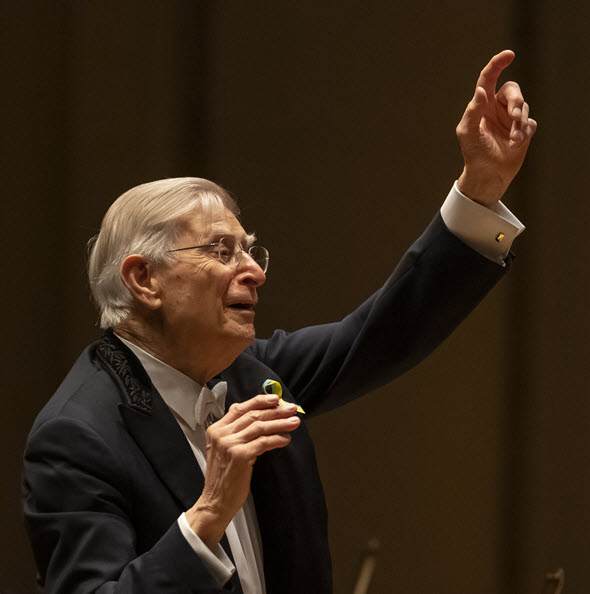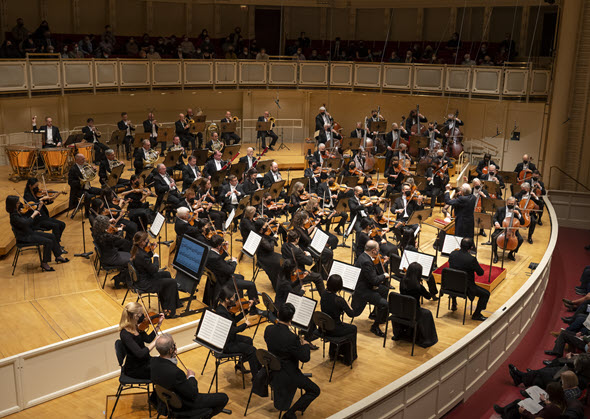Spring reveals Chicago Symphony a-bloom, with splendors of Bruckner and Mahler ahead

With minimal gestures, and no score, Herbert Blomstedt led the Bruckner Fourth Symphony. (Photos by Todd Rosenberg)
Commentary: Conductor Herbert Blomstedt’s magnificent Bruckner Fourth sets the stage for a stretch of showcase CSO concerts.
By Lawrence B. Johnson
The Chicago Symphony Orchestra under full sonorous sail is now, as it has been throughout my lifetime, something to behold. You might say we’re in the CSO’s season of high tide. Just ahead music director Riccardo Muti conducts Bruckner’s Second Symphony, and Jaap van Zweden, music director of the New York Philharmonic, comes in for the Mahler Sixth, an evening in itself. We got a regal reminder of just what this orchestra can summon – its Solti legacy, as I think of it – last week when Herbert Blomstedt conducted a spectacular account of Bruckner’s Symphony No. 4 in E-flat (“Romantic”).
I became aware of classical music as a boy growing up on the banks of the Wabash in Indiana, and central to that awakening were the Chicago Symphony’s recordings under Fritz Reiner. While Reiner and the CSO documented performances of the Strauss symphonic poems that may never be superseded, that legendary coalition ventured into Mahler on record only with the Fourth Symphony – a magical turn with soprano Lisa della Casa; but, alas, Reiner recorded nothing of Bruckner. That all changed with Georg Solti, who shepherded Chicago through complete symphonic cycles of both Mahler and Bruckner.
And as the Chicago Symphony commenced its international touring under Solti, sharing that glorious sound with the world, the reputation of the orchestra’s matchless brass ensemble grew into the ubiquitous adjective “vaunted.” That descriptor fit very well indeed when Blomstedt led the orchestra in Bruckner’s grandiose “Romantic” Symphony at Orchestra Hall.
Mahler liked to talk about creating whole worlds in his symphonies; Bruckner built cathedrals of sound and, like Bach, dedicated them to the glory of God. Think of the Fourth Symphony’s splendorous brass eruptions as light pouring through stained glass. The brilliance is almost unbearable. That’s how it registered in the Chicago Symphony brass in Blomstedt’s account of the work. And yet, by no means did those shattering climaxes tell the whole tale of the piece or of the performance. Blomstedt had the totality of the Fourth Symphony always in hand, or rather I should say in mind: He conducted without a score.
What Blomstedt did with the Bruckner Fourth was remarkable in several different ways, but not least in the sheer physical and intellectual achievement of a conductor who will turn 95 years old in July. He’s an efficient conductor who doesn’t wave his arms about needlessly, though his beat is not so miniscule as Reiner’s was. All the same, he eschewed the relief of a stool in favor of standing for the 66-minute Fourth Symphony. And to get down to musical truth, it’s one thing to conduct without a score and another to be completely on top of every expressive inflection at all times throughout the orchestra. That’s where Blomstedt was: on top, in front, wholly immersed.
And wonderfully unhurried. This was an ethereal Fourth, heroic, expansive, transcendent. Which is to say, Blomstedt dealt generously with Bruckner’s flowing lyricism, not only in the slow movement but also in all those quiescent intervals between the swelling towers of brass. In those reflective, often quite prayerful, episodes, it was the CSO woodwinds and strings that kept the tension and luster on the arcing line. It was an extraordinary experience, a performance as fragile and fine as it was monumental.
If the Fourth has always been the most popular of Bruckner’s works, the Symphony No. 2 in C minor is likely to be a discovery even for listeners generally familiar with Bruckner, those who may also know the Seventh, Eighth and Ninth. The symphony officially numbered 2 was in fact the fourth that Bruckner completed. There’s an early, unnumbered work and the so-called Symphony No. 0 (or “Die Nullte”). Muti, who is selective about which Mahler symphonies he will conduct, is a great Bruckner enthusiast. It’s intriguing, if not exactly surprising, that he should offer the comparatively neglected Second Symphony in his concerts March 31, April 1 and April 5.
What a different world – to use the composer’s own term – awaits when van Zweden conducts Mahler’s Symphony No. 6 in A minor in four performances April 21-24. Setting aside its radiant slow movement, the Sixth Symphony is the furthest thing from celestial: It is an existential essay, dark, stern, driving. It did not acquire the sobriquet “Tragic” for nothing. But this tremendous symphony in four movements, running some 85 minutes, is also a work of deceptive emotional gradients, virtuosic in its demands on the orchestra and challenging to any maestro who tackles it. A worthy measure of all that is vaunted about the Chicago Symphony Orchestra.




